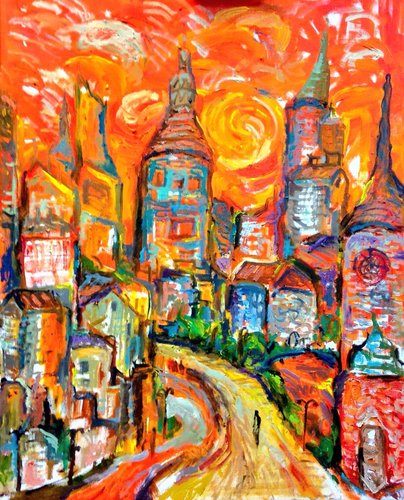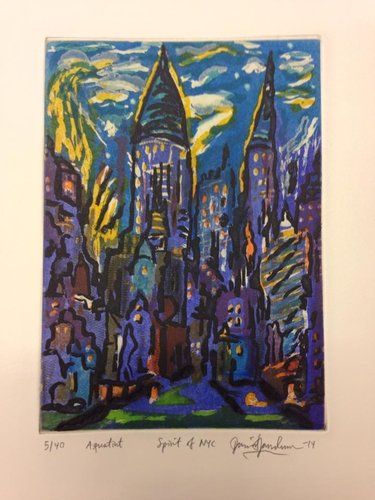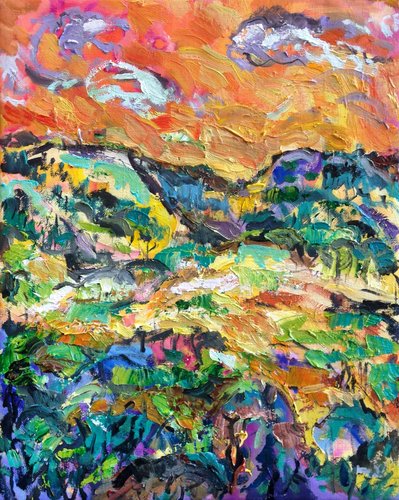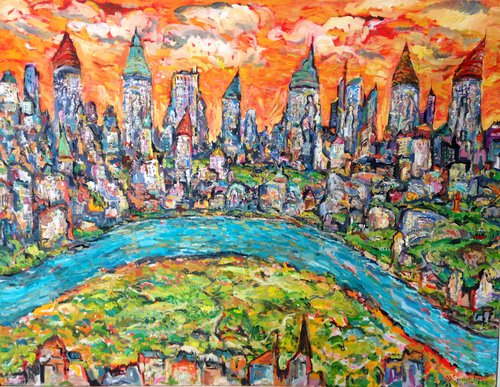by Carolyn Edlund
Swedish artist David Sandum shares a compelling story about overcoming depression through creative work.

“Into the City” Oil on canvas, 65 x 81cm
AS: Your new book I’ll Run Till The Sun Goes Down tells your own story, but what is your experience in speaking with other artists about the prevalence of depression in creative people?
DS: That’s a good question. Of course, not all artists are depressed, though most of those I’ve encountered have strong personalities. I once met an artist who said there is no such thing as inspiration, just hard work. He saw his job as a trade like any other and resented the idea that artists are often stereotyped as mad recluses, like Van Gogh. I can see his point, but I have always identified with Van Gogh, who painted his emotions. I definitely believe in cathartic expression and, yes, in inspiration.
Having said that, most artists are emotional people, and many have experienced some sort of emotional battle. Rejection issues, financial trouble, and relationship struggles usually lead to such feelings. To survive as an artist, you must have stubborn determination, focus, and an inner drive—as well as the awareness that it takes a long time to develop artistic skills. Today we have the mindset that everything should happen quickly. That is incompatible with creating quality art.
AS: During the time you were suffering from chronic depression, what led you to start painting? How did this make a difference?
DS: When I was at my lowest point, I felt drawn to art in an indescribable way. I would say I felt true empathy in art. I saw what I felt. Everything around me was chaos, but I saw exactly what I felt in one painting by Munch, Derain, or the mentioned Vincent. For a moment my agony was put on hold, or I felt an ability to fight— the cathartic dimension.

“Spirit of New York City” Aquatint etching, 2014
Many a time, I have entered my studio full of anxiety and hopelessness, only to leave five or ten hours later with a form of control. The hardest times are when self-hate and perfectionism strike, or when I am too ill to paint. Those days are nearly unbearable.
AS: Has your creative work changed your relationships with your family and friends?
DS: Being an artist is a lonely profession. Only you create. How do you share that with your loved ones? And creating takes place long before I put my brush to canvas. My wife often says, “You’re gone again. Where are you now?” Sometimes family members have seen my art as a threat, as though they will lose me to it. And in a way they have.

“Day in the Mountains” 41 x 33 cm
Then there are of course the challenging financial aspects—you and everyone around you must sacrifice to make it work. That is why many artists end up alone. Trying to communicate what I experience is also difficult. I have often felt unable to describe to them what I feel, especially when I withdraw for long periods.
Writing my book has been an attempt to explain to my loved ones and others. If they want to know what my illness feels like, and how much my art means to me, they can open the book and read. That is why it has been of uttermost importance to write an honest account. It has taken me fifteen years.

“Inspired by the Hudson” Oil on canvas, 2013-14, 125 x 95 cm
AS: Numerous artists have expressed that art has saved their lives, and it literally has made all the difference for you. How would you describe the way that your process of creating changes your perspective, or your experience of depression?
DS: I am in no doubt that art saved my life—because it is the only thing I could have done that was not entirely self-destructive. I once told a journalist, “I could have started on heroin, but I started to paint.” When you suffer, you must do something with that suffering.
That is why my goal is to always paint my emotions. A statement by Munch, who was inspired by the Bohemian writer Hans Jæger, is frequently on my mind. He said you should paint your life story, exclaiming, “No longer shall I paint interiors with men reading and women knitting. I will paint living people who breathe and feel and suffer and love.”
I try to do the same, no matter what the motif. Color is my main vehicle to do so. Sometimes color is more important to me than the motif. Here, studying expressionists like the Blue Rider movement (1911–1914), spearheaded by Kandinsky, has been crucial. His book, Concerning the Spiritual in Art (1912) is an art bible for me that every artist should read.
 Sandra Jonas Publishing produced this memoir by artist David Sandum. Originally from Sweden, he currently lives and works in Moss, Norway.
Sandra Jonas Publishing produced this memoir by artist David Sandum. Originally from Sweden, he currently lives and works in Moss, Norway.



Yes to ALL of this: words and images.
I look forward to reading Sandum’s memoir.
I can really relate to what you are saying. I look forward to reading your book!
Good article. I once asked a artist struggling with depression if he or others knew of very DIRECT expressions in paint of pain and despair…aside from Munch,s scream. I titled one of my painful experience expressions The Unheard Scream. I see emotions in paint but I am curious if artists do direct narratives in paint. One of the artists I admire says there is no narrative art. To David. I love your work…and that you have found your voice and your courage!
I definitely can relate to this article. When I sought professional help due to stress and depression, he told me that I needed something outside of work and family and asked if I liked doing anything. Then I remembered; long ago as a teenager, before bills and family came into play; I had wanted to be an artist. But with the need for money to support my children, I’d completely ignored my first love because it was trivial and costly. But when the doctor told me I should paint again, if it made me happy; that’s all the reason I needed. Words can’t explain how picking up a paint brush gave my life new meaning! Although I am still distant from others and money is still an issue; I now have something that I can hold on to that helps me get out what I’d been hold in for so long. Now, I not only paint; I write poetry & enjoy photography as well!
Great interview and congrats to David for finishing his earnest memoir that I think will help and inspire others who also suffer/suffered from depression. I look forward to reading it.
David,painting has been a wonderful catalyst in helping me to move on & forward. It has been a medicine no doctor could prescribe for me. I look forward to your book. Thanks for sharing your struggle.